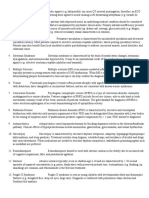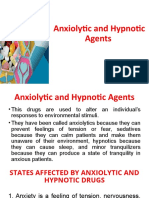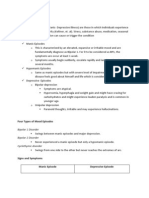Antimania Drugs
Antimania Drugs
Uploaded by
39 Nayan BhagatCopyright:
Available Formats
Antimania Drugs
Antimania Drugs
Uploaded by
39 Nayan BhagatOriginal Title
Copyright
Available Formats
Share this document
Did you find this document useful?
Is this content inappropriate?
Copyright:
Available Formats
Antimania Drugs
Antimania Drugs
Uploaded by
39 Nayan BhagatCopyright:
Available Formats
Anti-Mania Drugs
ANTIMANIC DRUGS
Contents
• Mania
• Lithium Carbonate
• Pharmacological Profile
References
• Essentials of Pharmacology by KD Tripathi, Page No. 434-437
• www.google.com
• Mania is the mood of an abnormally elevated arousal energy level. Elevated
irritability is common along with behavior that seems on the surface to be the
opposite of depression
• Elevated mood is significant and is known as mania or hypomania depending on
the severity.
• They often make poorly thought out decisions with little regard to the
consequences. The need for sleep is usually reduced
• During periods of depression there may be crying, poor eye contact with others,
and a negative outlook on life.
• It is divided into bipolar I disorder if there is at least one manic episode and bipolar
II disorder if there are at least one hypomanic episode and one major depressive
episode.
Dept. of Pharmacology, MIP, Pune Page 1
Anti-Mania Drugs
• Treatment commonly includes psychotherapy and medications such as mood
stabilizers or antipsychotics. Examples of mood stabilizers that are commonly
used include: lithium and anticonvulsants
• In periods of mania it is recommended that antidepressants be stopped. If
antidepressants are used for periods of depression they should be used with a
mood stabilizer. Electroconvulsive therapy may be helpful in those who do not
respond to other treatments
• If treatments is stopped it is recommended that this be done slowly. Most people
have social, financial or work related problem due to the disorder.
Lithium Carbonate
• It is used in bipolar disorder i.e. is a mental illness characterized by periods of
elevated mood and periods of depression. The elevated mood is significant and is
known as mania or hypomania depending on the severity.
• It is neither sedative nor euphorient, but on prolonged administration it act as
mood stabilizer
• Given in mania it gradually suppresses the episode taking 1-2 weeks continued
treatment prevents cyclic mood changes.
• Mechanism of action not known. Lithium carbonate is used to treat mania, the
elevated phase of bipolar disorder Lithium ions interfere with ion transport
processes (see “sodium pump”) that relay and amplify messages carried to the
cells of the brain. Mania is associated with irregular increases in protein kinase C
(PKC) activity within the brain. Lithium carbonate and sodium valproate, another
drug traditionally used to treat the disorder, act in the brain by inhibiting PKC’s
activity and help to produce other compounds that also inhibit the PKC
Dept. of Pharmacology, MIP, Pune Page 2
Anti-Mania Drugs
• Lithium inhibits the action of ADH on distal tubules and causes a diabetes
insipidus like state.
• It has some insulin like action on glucose metabolisms
• Leucocyte count is increased by lithium therapy
Pharmacokinetics
• Lithium is slowly but well absorbed orally and is neither protein neither bound
nor metabolized.
• It first distributes in the extracellular water and then gradually enters cells and
slowly penetrates into the CNS, attains uniform distribution in total bod water
• It is handled by the didney in much the same way as Na
• When Na is restricted a larger fraction of filtered NA is reabsorbed
• It is excreted in sweet and saliva also and in breast milk
• Adverse Effect
• Side effects are common but are mostly tolerable.
• Toxicity occurs at levels only marginally higher than therapeutic levels
• Nausea, vomiting and mild diarrhea occur initially, can be minimized by starting
at lower doses
• Thirst and polyuria are experienced by most, some fluid retention may occur
initially
• Fine tremors and rarely seizures
Dept. of Pharmacology, MIP, Pune Page 3
Anti-Mania Drugs
• Ataxia, giddiness, confusion, slurred speech, coma, convulsions, drowsiness,
diarrhea
• Interactions
• Diuretics by causing Na loss promote proximal tubular reabsorption
• Tetracycline, NSAIDs and ACE inhibitors can also cause lithium retention.
• Lithium reduces pressor response to NA
• Lithium tends to enhance insulin/sulfonylurea induced hypoglycemia
• Succinylcholine and Pancuronium have produced prolonged paralysis in lithium
treated patients.
• Use
• Acute mania
• Prophylaxis of bipolar disorder
Dept. of Pharmacology, MIP, Pune Page 4
You might also like
- NCM 117 Psychiatric Nursing MODULE 7Document27 pagesNCM 117 Psychiatric Nursing MODULE 7Meryville JacildoNo ratings yet
- Understanding Depression: A Complete Guide To Its Diagnosis and TreatmentDocument201 pagesUnderstanding Depression: A Complete Guide To Its Diagnosis and TreatmentElse FashiosNo ratings yet
- Drugs in Psychiatric NursingDocument38 pagesDrugs in Psychiatric NursingJSeasharkNo ratings yet
- Kenneth Manzanares Sentencing Memo DefenseDocument38 pagesKenneth Manzanares Sentencing Memo DefenseNational Content DeskNo ratings yet
- Uworld - PSYCHIATRYDocument24 pagesUworld - PSYCHIATRYNikxyNo ratings yet
- Antipsychotic DrugsDocument18 pagesAntipsychotic Drugsraphaelngalati480No ratings yet
- 220 Mood StabilizersDocument4 pages220 Mood Stabilizersanggana putriNo ratings yet
- Mood StabilizersDocument6 pagesMood StabilizersLan FdzNo ratings yet
- Alzheimer PDFDocument4 pagesAlzheimer PDFFarhana 1612688049No ratings yet
- Lithium Final 2Document42 pagesLithium Final 2Neha PashineNo ratings yet
- Bipolar Disorder DrugsDocument17 pagesBipolar Disorder Drugsrohaans190No ratings yet
- PsychopharmacologyDocument51 pagesPsychopharmacologyjay dewanagnNo ratings yet
- Direct File Topic DownloadDocument14 pagesDirect File Topic Downloadxopido9776No ratings yet
- Antimaniac & Mood Stabilizing DrugsDocument13 pagesAntimaniac & Mood Stabilizing DrugsNikhat KadriNo ratings yet
- 3 - Bipolar DisorderDocument20 pages3 - Bipolar DisorderrazAn swNo ratings yet
- Bipolar and Schizophrenia (New)Document96 pagesBipolar and Schizophrenia (New)Mohamed ElshahatNo ratings yet
- Antimanic DrugsDocument24 pagesAntimanic DrugsRamya RNo ratings yet
- Chlorpromazine: Brands If It WorksDocument6 pagesChlorpromazine: Brands If It WorksAnonymous cwlpSlReUYNo ratings yet
- Bipolar I Lec3Document6 pagesBipolar I Lec3lenato.revolutionNo ratings yet
- Psych MedsDocument46 pagesPsych MedsEvan Marie PalaparNo ratings yet
- Antimanic DrugsDocument24 pagesAntimanic DrugsAlina AnwarNo ratings yet
- PsycoDocument6 pagesPsycoجهاد إبراهيمNo ratings yet
- Archivetempfinal RevisionDocument140 pagesArchivetempfinal RevisionSheza FarooqNo ratings yet
- Drugs of DependencyDocument13 pagesDrugs of Dependencybrianmuthomi851No ratings yet
- BAD, Mania and OCDDocument27 pagesBAD, Mania and OCDsashika dharmasiriNo ratings yet
- Opioid Dependence: DR Ayedh AlkhademDocument39 pagesOpioid Dependence: DR Ayedh AlkhademAyedh TalhaNo ratings yet
- UntitledDocument12 pagesUntitledMustapha ImadudeenNo ratings yet
- AddictionDocument35 pagesAddictionEnash RidNo ratings yet
- Nursing-Bullets Compress PDFDocument73 pagesNursing-Bullets Compress PDFheluNo ratings yet
- Bipolar Lecture11Document5 pagesBipolar Lecture11hhanono924097No ratings yet
- AddictionDocument43 pagesAddictionBright SunshinenNo ratings yet
- Mood Stabilizers-Amanat Ali-1Document33 pagesMood Stabilizers-Amanat Ali-1Syed Sanan shahNo ratings yet
- Mood Stabilizers Group 3Document28 pagesMood Stabilizers Group 3Dr. Aron Kipaka, MDNo ratings yet
- Antipsychotic DrugsDocument28 pagesAntipsychotic Drugshassentullo430No ratings yet
- Nm-Lec17 - Psychoactive Agents & LithiumDocument20 pagesNm-Lec17 - Psychoactive Agents & Lithiumgeng gengNo ratings yet
- BPAD FinalDocument31 pagesBPAD FinalZANo ratings yet
- Substance Abse IDocument21 pagesSubstance Abse Ieliza.koiralaNo ratings yet
- Lithium & Other Drugs Used in Maniac Depressive Disorder LPDocument6 pagesLithium & Other Drugs Used in Maniac Depressive Disorder LPMichele PircioNo ratings yet
- Anxiolytic and Hypnotic AgentsDocument50 pagesAnxiolytic and Hypnotic AgentsMoxie Macado100% (1)
- Module-10-Lecture-4 - Cannabis, Mental Health, and Brain DisordersDocument13 pagesModule-10-Lecture-4 - Cannabis, Mental Health, and Brain DisordersAbdul Aziz Success CoachNo ratings yet
- Alcoholism: Alcohol Withdrawal SymptomsDocument8 pagesAlcoholism: Alcohol Withdrawal SymptomsMonnesJNo ratings yet
- Seminar 6 - Psychopharmacology - EctDocument108 pagesSeminar 6 - Psychopharmacology - EctA. TivieanNo ratings yet
- Description: Four Types of Mood EpisodesDocument4 pagesDescription: Four Types of Mood EpisodeskhinayoNo ratings yet
- AntidepressantsDocument36 pagesAntidepressantsmuhirederick50No ratings yet
- Substance Related DisorderDocument41 pagesSubstance Related Disordersanfranciscojulie22No ratings yet
- Psychotropic DrugsDocument81 pagesPsychotropic DrugsJoan100% (2)
- Module 1Document24 pagesModule 1Jinz BinagNo ratings yet
- KU Yr 6 Psychopharmacology IIDocument41 pagesKU Yr 6 Psychopharmacology IIJuliax ClintonNo ratings yet
- Common Psychiatric conditions at Butabika hospital pptDocument37 pagesCommon Psychiatric conditions at Butabika hospital pptIrahuka CliftonNo ratings yet
- AntianxietyDocument8 pagesAntianxiety39 Nayan BhagatNo ratings yet
- Anxiolytics & AntidepressantsDocument34 pagesAnxiolytics & AntidepressantsIconMaicoNo ratings yet
- Anti AnxietyDocument17 pagesAnti Anxietygollaveeresh457No ratings yet
- Depressants 210919065841Document26 pagesDepressants 210919065841Bry PeterosNo ratings yet
- Fluoxetine & Citalopram DRUG STUDYDocument3 pagesFluoxetine & Citalopram DRUG STUDYJoab StainesNo ratings yet
- Affective Bipolar Disorder Episodes Kini ManiaDocument16 pagesAffective Bipolar Disorder Episodes Kini ManiaDeasy Arindi PutriNo ratings yet
- Drug Study of FluoxetineDocument2 pagesDrug Study of FluoxetineLance De GuzmanNo ratings yet
- BarbituratesDocument19 pagesBarbiturateslockairtimeservicesNo ratings yet
- Introduction ClinicalDocument4 pagesIntroduction ClinicaljzariziNo ratings yet
- Module 8Document5 pagesModule 8Yuki Xairah TunayNo ratings yet
- Substance Abuse Use DisorderDocument25 pagesSubstance Abuse Use DisorderHetal BhakhariyaNo ratings yet
- Mood Stabilizing AgentsDocument21 pagesMood Stabilizing AgentsHamze Abdullah Al-ShawaheenNo ratings yet
- Eatiing DisordersDocument69 pagesEatiing DisordersMasa MasaNo ratings yet
- IV. Antiepileptic DrugsDocument31 pagesIV. Antiepileptic DrugsDanica AbarquezNo ratings yet
- Medical Encyclopedia XXL: Prof. J.P. Schadé, M.D., Ph.D. D.Sc.hcFrom EverandMedical Encyclopedia XXL: Prof. J.P. Schadé, M.D., Ph.D. D.Sc.hcNo ratings yet
- HTML fdc1Document18 pagesHTML fdc139 Nayan BhagatNo ratings yet
- Antiparkinsons DrugsDocument19 pagesAntiparkinsons Drugs39 Nayan BhagatNo ratings yet
- General AnesthesiaDocument17 pagesGeneral Anesthesia39 Nayan BhagatNo ratings yet
- AntianxietyDocument8 pagesAntianxiety39 Nayan BhagatNo ratings yet
- Borderline Personality Disorder and Adolescent Suicide Attempt: The Mediating Role of Emotional DysregulationDocument10 pagesBorderline Personality Disorder and Adolescent Suicide Attempt: The Mediating Role of Emotional DysregulationsiphokaaziNo ratings yet
- Chapter 4Document42 pagesChapter 4Athira RaghuNo ratings yet
- The And: Hospital Anxiety Depression ScaleDocument10 pagesThe And: Hospital Anxiety Depression ScaleDiana MuñozNo ratings yet
- The Primacy of Mania - A Reconsideration of Mood DisordersDocument10 pagesThe Primacy of Mania - A Reconsideration of Mood DisordersManoel Vicente Barros JuniorNo ratings yet
- Depression HandoutDocument1 pageDepression Handoutapi-290668891100% (1)
- Mental Health Case Study 1Document12 pagesMental Health Case Study 1api-507291324No ratings yet
- Chapter-1 2Document36 pagesChapter-1 2JustinNo ratings yet
- NCP 1Document2 pagesNCP 1Camille SesaldoNo ratings yet
- Original Article: Bipolar Disorders. 2021 00:1-22Document22 pagesOriginal Article: Bipolar Disorders. 2021 00:1-22Carolina MuñozNo ratings yet
- CH 4 - Psychological DisordersDocument20 pagesCH 4 - Psychological DisordersMayookhaNo ratings yet
- Chapter 16: Schizophrenia: Tomorrow: Chapter 17: Mood Disorders and SuicideDocument65 pagesChapter 16: Schizophrenia: Tomorrow: Chapter 17: Mood Disorders and SuicideRainier Moreno-LacalleNo ratings yet
- Symptoms of Dru-WPS OfficeDocument25 pagesSymptoms of Dru-WPS OfficeAlexa NicoleNo ratings yet
- Postpartum Mood Disorders PPT. Cohen MDDocument54 pagesPostpartum Mood Disorders PPT. Cohen MDKavi rajputNo ratings yet
- Depression Medication Author: Jerry L Halverson, MD Chief Editor: David Bienenfeld, MD Practice EssentialsDocument128 pagesDepression Medication Author: Jerry L Halverson, MD Chief Editor: David Bienenfeld, MD Practice EssentialsLauria Cindika SariNo ratings yet
- Characterization of Depressive Syndrome in Schizophrenic OutpatientsDocument8 pagesCharacterization of Depressive Syndrome in Schizophrenic OutpatientsdevNo ratings yet
- 30 Soal Akm Big Wajib Kelas XiDocument12 pages30 Soal Akm Big Wajib Kelas Xiastrophile2802No ratings yet
- Segment 3. Mood-WPS OfficeDocument5 pagesSegment 3. Mood-WPS OfficeLicaycay StiffanyNo ratings yet
- Suicide An Overview For CliniciansDocument12 pagesSuicide An Overview For CliniciansJuan Dario Mogollon SepulvedaNo ratings yet
- Chapter 14 Psychological Disorders Practice Problems - AnswersDocument13 pagesChapter 14 Psychological Disorders Practice Problems - AnswersisraNo ratings yet
- Antidepressants in Bipolar Depression: An Enduring ControversyDocument7 pagesAntidepressants in Bipolar Depression: An Enduring ControversyAgusNo ratings yet
- Mood Disorder & Suicide - Group 5 Written ReportDocument11 pagesMood Disorder & Suicide - Group 5 Written Reportojk jlNo ratings yet
- Chapter 4 - (Philoid-IN) PDFDocument20 pagesChapter 4 - (Philoid-IN) PDFThiagarajan KuttiannanNo ratings yet
- Joker Final Edition 23 de Junio - Google Docs2023Document73 pagesJoker Final Edition 23 de Junio - Google Docs2023AGUSTINA SOSA REVOLNo ratings yet
- PhyscDocument50 pagesPhyscdocivirusNo ratings yet
- Understanding The Experiences of Grade-11 HumssDocument57 pagesUnderstanding The Experiences of Grade-11 HumssBLANCHE BUENONo ratings yet
- Mental HealthDocument9 pagesMental HealthPatrick JoshuaNo ratings yet




























































































